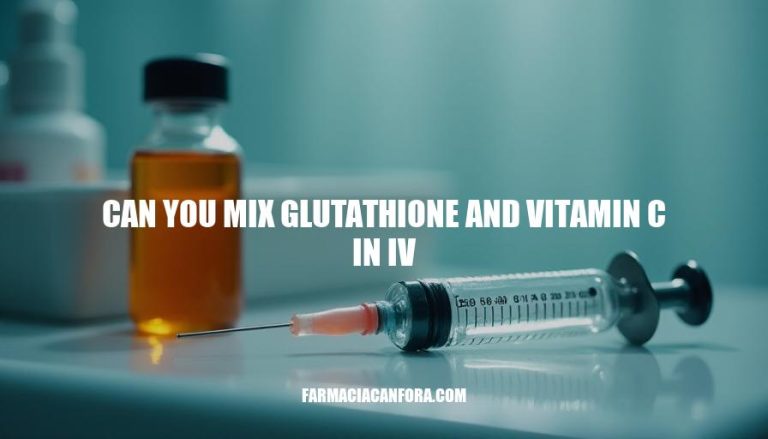


Mixing glutathione and vitamin C in intravenous (IV) therapy is a topic of growing interest due to the potential health benefits of both antioxidants. Understanding this combination is crucial as it can enhance detoxification, boost immune function, and improve skin health. However, proper administration is essential to ensure optimal absorption and effectiveness.
Combining glutathione and vitamin C in IV therapy can offer several potential benefits:
Enhanced Antioxidant Effects: Both glutathione and vitamin C are powerful antioxidants. When administered together, they can replenish and recycle each other, enhancing their ability to neutralize free radicals. This synergy helps reduce oxidative stress, which is linked to various health issues and aging.
Improved Skin Health: This combination is known for its skin-brightening effects. Glutathione can reduce melanin production, leading to a lighter skin tone, while vitamin C boosts collagen production, improving skin elasticity and reducing wrinkles. Together, they can result in healthier, more radiant skin.
Immune System Support: Both antioxidants play crucial roles in supporting the immune system. Glutathione helps detoxify the body and supports liver function, while vitamin C is essential for immune defense. Their combined effect can enhance overall immune function.
Detoxification: Glutathione is vital for detoxifying harmful substances in the body. When combined with vitamin C, it can enhance the detoxification process, supporting liver health and overall wellness.
Mixing glutathione and vitamin C in IV therapy can offer benefits but also carries potential risks and side effects:
Potential Risks and Side Effects:
Importance of Proper Dosage and Medical Supervision:
Always consult a healthcare professional before starting any IV therapy to ensure it’s safe and appropriate for your specific health condition.
Here are some key findings and expert opinions on the combination of glutathione and vitamin C in intravenous (IV) therapy:
Synergistic Effects: Glutathione and vitamin C have a synergistic relationship. Glutathione helps regenerate antioxidants such as vitamin C, and vitamin C helps maintain glutathione levels. This combination can enhance antioxidant capacity and reduce oxidative stress.
Cancer Treatment: High-dose intravenous vitamin C (IVC) has shown potential as an anti-cancer agent. It can act as a pro-oxidative cytotoxic agent, epigenetic regulator, and immune modulator. Combining IVC with glutathione may enhance these effects, although more clinical trials are needed to confirm efficacy.
Neuroprotection: Intravenous glutathione has been used to reduce neurotoxicity associated with chemotherapy, particularly cisplatin. This combination may offer neuroprotective benefits, especially in conditions like Parkinson’s disease.
Pharmacokinetics: Intravenous administration of glutathione results in significantly higher plasma concentrations compared to oral administration. This method allows for more effective delivery and utilization of glutathione in the body.
Safety and Tolerability: Both intravenous vitamin C and glutathione are generally well-tolerated in clinical trials. However, the safety profile should always be considered, and treatments should be administered under medical supervision.
These findings highlight the potential benefits and applications of combining glutathione and vitamin C in IV therapy, but further research is necessary to fully understand their synergistic effects and optimal usage.
These protocols help ensure the safe and effective use of glutathione and vitamin C in IV therapy. Always consult with a healthcare provider for personalized recommendations.
The combination of glutathione and vitamin C in IV therapy has potential benefits, including enhanced antioxidant effects, improved skin health, immune system support, and detoxification. However, proper administration is crucial to ensure optimal absorption and effectiveness.
Risks and side effects include allergic reactions, injection site discomfort, temporary fatigue or dizziness, oxidative stress, and nutrient interactions. Proper dosage and medical supervision are essential to minimize these risks.
The synergistic relationship between glutathione and vitamin C can enhance antioxidant capacity and reduce oxidative stress. This combination may also offer benefits in cancer treatment, neuroprotection, and pharmacokinetics.
Safety and tolerability should always be considered, and treatments should be administered under medical supervision. Best practices for administering glutathione and vitamin C in IV include proper dosage, preparation, administration, monitoring, and storage. Patient assessment, sterility, hydration, professional supervision, and documentation are also essential guidelines to follow.
Ultimately, the combination of glutathione and vitamin C in IV therapy has potential benefits, but further research is necessary to fully understand their synergistic effects and optimal usage.